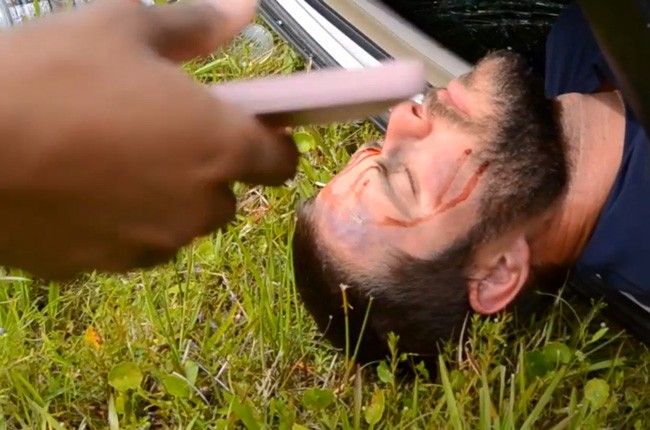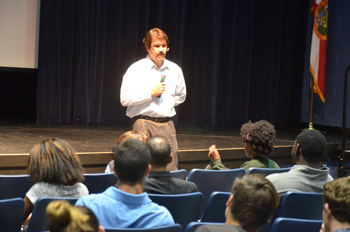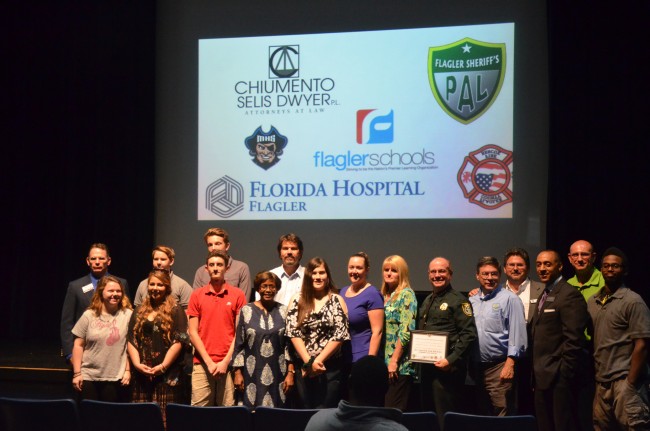
Note: the video is at the foot of the article.
Michael Chiumento, the lawyer, was at a stop light about eight months ago. “I picked up my phone to look at who had texted me,” he said, “and my 11-year-old son yelled at me. He said, ‘Dad, you can’t text and drive.’ And I said I’m not, I’m stopped. He says, ‘No, you can’t look at your phone. It’s distracted driving.’ It’s true. That’s right.”
Chiumento is familiar with the consequences of distracted driving from another angle: his Palm Coast firm, Chiumento Selis Dwyer, represents numerous clients involved in one way or another in car wrecks, a large segment of whom because of distracted driving. “One out of every four accidents that happen in the United States are the result of distracted driving,” he said, based on national statistics.
Keeping his son’s warning in mind, he had discussions with colleagues at the office, thinking up ways to address texting and driving in a more broadly preventive way. From there, discussions developed with the Police Athletic League, the Flagler County Sheriff’s Office, Flagler County Fire Rescue, the school board, and Florida Hospital Flagler, where treating people in wrecks from distracted driving is routine. The coalition decided to put together a campaign, which turned into a student project for a video public service announcement, in Tracey Hicks’s class at Matanzas High School.
Wednesday evening, Chiumento and his partners, with the student production team in attendance, premiered the video PSA at Matanzas’ Pirates Theater and before a small but enthusiastic crowd that included Sheriff Jim Manfre, School Board member Andy Dance, County Commissioner Nate McLaughlin and other coalition representatives.
“At first it was, let’s talk to the students because the students are the ones who are texting and driving,” Chiumento told the audience, addressing a contingent of students especially. “The reality is, you guys are smarter than us, and you already know the dangers. It’s the parents that are doing it, and that’s why we need your help.”
A group of a half dozen students or so volunteered their time to produce the video. “My students worked really, really hard on this project,” Hicks said. “I fortunately had a group of them every single day, so we talked about the project every single day, and they probably got tired of me, but I think the end results were worth it.”
Chiumento then showed the piece, with an advisory: “It will make your skin crawl at the end.”
The video starts and ends with the sound of a heart monitor—and a visual and audible flatline. In between, a young woman and a young man are seen driving on a familiar local road, approaching each other from opposite directions. (Oddly, the woman’s wheel is on the right side, as if she were in a British vehicle, though that’s not germane to the message.) The man is listening to music, not speeding, not doing anything out of the ordinary. His eyes are on the road.
The woman appears also attentive at first. But then she reaches for her cell phone. She got a text. “Hey, is Josh going to be there?” she’d just written. “Of course he is,” someone on the other end replies.
That’s when the driver starts thumbing a reply, her left hand on the wheel, her right hand around the phone, her thumb on the keyboard, her eyes all over the place. She types Lol. She presses send.
And she immediately swerves over the yellow center line.
The screen goes dark. A crashing sound. The music stops. It’s replaced by slow-motion sounds. The woman is a bit bloodied. She gets out of the car and screams an “Oh, my God.” The man’s car has overturned. It’s in a ditch. He’s unresponsive. (John’s Towing, the Bunnell wrecker, donated the car.)
What happens next is a sequence grimly familiar to first responders: the extrication of the victim, strapping him down on a gurney, taking him to an awaiting helicopter for a trauma evacuation—Flagler County Fire Flight, the county’s emergency helicopter—all as the woman watches from inside a police cruiser.

The victim is dead on arrival as the scene shifts to Florida Hospital Flagler. The woman’s voice is heard intoning the grim play on word on top of the sound of the flatline: “Was my laugh out loud worth his loss of life?”
There’s nothing exaggerated about the scenario. If anything, it’s considerably understated: trauma victims usually look disturbingly mangled, the shattered lives are not theirs alone, and the consequences are felt over years that a 150-second video cannot convey. (Typically a trauma alert and air evacuation would send the patient to Halifax hospital, which has a trauma unit. But for dramatic effect in this case, the patient is flown to Florida Hospital Flagler, one of the partners in the PSA effort. Most non-trauma crash victims are, in any case, transported to the local hospital.)
The difference in this case was that when the theater lights came back on, all was well. “You guys did an amazing job. It’s moving,” Chiumento told the students.” I think you’re going to send a message once this gets out.”
“That was great. I saw it for the first time with everybody else,” Dance, the school board member, said. “I was very moved, especially with the sequence of the helicopter and the ambulance. I think they did a great job.” He noted that the local landmarks, easily recognizable by local viewers, “is better than some generic PSA from somewhere else, so I think it’ll have a bigger impact.”
The Sheriff’s Office’s Don Apperson, who makes a cameo in the video and was in attendance (he is retiring soon after 25 years), has seen the consequences of traffic deaths from most sides—as a long-time school resource deputy, as a law enforcement officer on the roads, as a family friend in families’ most trying circumstances. He described one such instance years ago, before the era of cell phones—but not before the era of distracted or inexperienced driving—when he was asked to speak at the funeral of 14-year-old Teddy Gardner, who died in March 2004 in a wreck on I-95. He was riding with his father and 16-year-old brother, who had just gotten his permit and was at the wheel. Teddy was not wearing a seat belt and was ejected. “That was the toughest thing I’ve ever had to do,” Apperson said, shortly after viewing the PSA video. “I don’t ever want to do that again. That was by far the toughest thing I’ve ever had to do in law enforcement, speak at the funeral of a young man.”
Texting and driving is against the law, but it’s a secondary offense right now, which means that police may not pull over anyone with texting as the reason: it must be part of another, primary offense, such as speeding or blowing through a stop sign, or not wearing a seat belt (which used to be a secondary offense). The sheriff said the state sheriff’s association keep lobbying the Legislature to make texting and driving a primary offense. “Our deputies view it, but there’s nothing we can do unless it’s incident to another viewing violation,” Sheriff Manfre said. There’s been local citations, but they’re “hard to prove unless you view it. No one admits to it. It’s one of those difficult things. It arises more when there’s a vehicular homicide investigation, you then investigate whether the person was actually on the phone, you subpoena the records to see if there was actually a distraction.”
Next year, Chiumento said, there may be another one or two PSAs, pushing the notion into middle schools and coming up with new ideas that, again, students would lead and develop.
“Our group here will help you get this message out,” he told the students, “and we’ll take it into next year and help it get really big.”
![]()
The PSA is the work of Matanzas High School students Aaron Goodwin, Geraldine Jeannot, Christopher Cellini, Jirawadee Battenhouse, Ruairi Songer, Jarrod Connors, Kyle Darby, Alexis Clayton and Casondra Osmun.






























Daily says
Every time I drive I see someone texting and driving, it’s not just kids. Yesterday alone I encountered at least 2 drivers swerving all over the road, slowing down, speeding up and one rear end collision. Distracted driving is becoming an epidemic as our technology improves and our cars become living rooms on wheels.
I don’t touch my phone while driving, I pull over to safety or wait till I get to my destintion. My kids have their phones taken away if they are found using it while driving!
Beach Guy says
Great video, but why at the 26 second mark does the female driver appear to be driving from the right side of the vehicle? Just curious, and nicely done.
Just a thought says
I’m sure they tried to get it as realistic as possible.
Heading North says
Congrats to all involved! Excellent presentation and video.
Compliments to the students, paramedics,firefighters,and Deputy Apperson.
Well done to all, and a very worthy message conveyed.
As for Sheriff Manfre’s comments, also well worded and to the point. However, he failed to mention the Florida Highway Patrol, who investigate ALL traffic fatalities and vehicular homicides in Flagler County.
Perhaps he should check the statistics again. I doubt his office has investigated any fatal accidents in years.
They are however first on scene and do an excellent job preserving scenes, gathering witnesses, no aiding in whatever way they can while awaiting the arrival of a State Trooperl who may be responding from another county.
Kudos to ALL involved in this moving production!
Be well, citizens of Flagler County!!
a tiny manatee says
YOLO
Jean MacAllister says
I am fortunately still alive, but the accident that totaled my car last September in Gainesville was due to a young woman being on her phone and not paying attention to her driving. She is okay, I am left with facing surgeries for knee and shoulder and constant pain. Whatever you are texting is not that important, you can always do it later, you cannot undo an accident.
Tom Hanson says
Congratulations to the Matanzas HS video students and to their instructor, Tracey Hicks. A very timely message conveyed in a very strong manner. Nicely done! Kudos to all agencies, sponsors and supporters of this video.